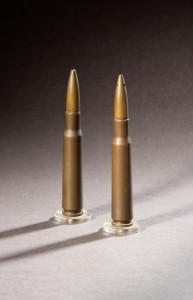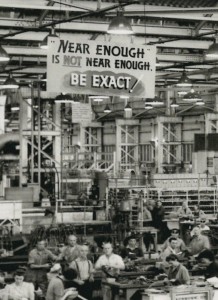Last year we featured records created during World War II by the NSW State Government on our website. They have included examples of the NSW government reaction to the bombing of Darwin, NSW Preparations for war as well as NSW under attack, we hope that you have enjoyed seeing these.
We would like to post something completely different to highlight the fourth and last part of our War and Australia: World War II digital display. This part of the display features the work of manufacturing and transporting defence supplies within NSW, especially by the NSW Government Railways.
Trench Art
Firstly a contribution from a staff member. When my colleague, also called Jenny, first heard back in February 2012 that we were mounting a display about the war in Darwin, she brought in these salt and pepper shakers to show us. They were made from American .50 BMG cartridges by her grandfather, William Howard, whilst he was stationed at Darwin. He enlisted in the Australian Army on 12 October 1941 and was discharged on 1 September 1945.
The .50 caliber cartridges were manufactured by Remington Arms in 1942, as shown on their headstamps, and were of the type used in the Browning M2 machine gun. They are 14cm long in total. The length of the casing (10cm) provides plenty of space for salt or pepper. Thanks to Andrew, another staff member and Army Reservist, for helping us identify them. More information about this type of ammunition can be found at this site . We thought the salt and pepper shakers were extraordinary and deserved to be seen. And here they are!
They are an example of trench art. See the Australian War Memorial’s website for other examples of trench art using bullets including a Trench art cross and a Bullet Casing cigarette lighter.
Workplace Signs
Secondly, a collection of signs found in the background of images of the Aircraft Production Factory at the NSW Government Railways Chullora Workshops. We have used one of these images in the latest part of the display. But the others were just too interesting to ignore! These signs vividly convey what was at stake. Did they work as a daily reminder or did they just become part of the scenery, like safety signage in our modern workplaces?
‘You can’t spell Victory with an absent “T”‘ detail from NRS 17420 item 603/27 showing staff during the visit of the Duke and Duchess of Gloucester to the Chullora Workshops 9 March 1945.
‘Near enough is not near enough. Be exact!’ detail from NRS 17420 item 603/57 Aircraft factory, Chullora, c.1943.
‘A concealed mistake is a crime! It may cost a brave man his life’ detail from NRS 17420 item 603/58 Aircraft factory, Chullora, c.1943.
Care to share?
Do you have examples of trench art or reminiscences that you would like to share? Or maybe a link to a favourite example on the web. Let us know in the comments.
Jenny Sloggett is an Archivist working in the Archives Control and Management section of State Records NSW.




